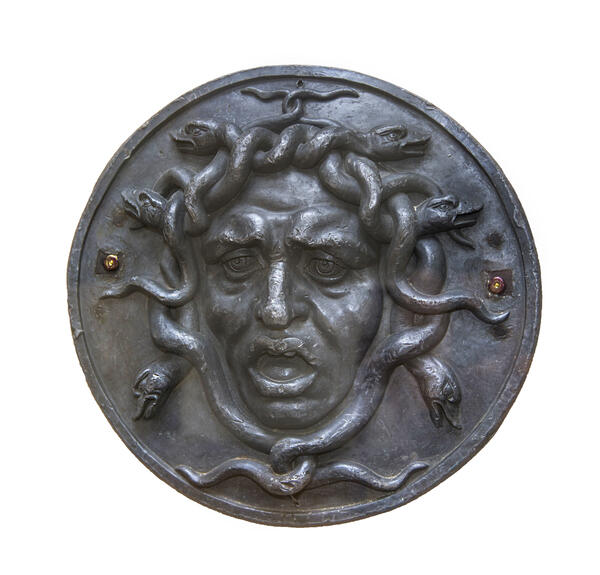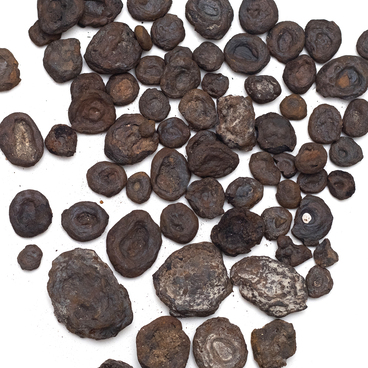The “Journey Through the Centuries” exhibition presents a detail of the decoration of the bridge or embankment railings, a round-shaped shield with the image of the head of Medusa. It was expected that it would be held on special mountings, for which four holes are provided. This decorative element was cast at the Alexandrovsky plant in Petrozavodsk in the first half of the 19th century.
At the Alexandrovsky plant, models for creating an imprint in the molding mixture (sand and clay) were often cast from lead. The products of the plant were branded writing either “OZ”, the Olonets factories (a group that included enterprises in Petrozavodsk, Konchesero, Suoyarvi, Kronstadt and St. Petersburg), or “Alexa Plant”, or simply “AZ” and the year of manufacture was necessarily written there.
To make the plant work in peacetime, its head Charles Gascoigne came up with “civilian” production directions. Cast-iron fences, railing, household utensils, interior items were cast there. The decorative detail of the bridge railing was custom-made, but the name of the customer remained unknown.
Medusa, whose head is depicted on the shield, is a character of ancient Greek mythology. King Polydectes assigned Perseus to kill the serpent-haired monster gorgon named Medusa. The gods Athena and Hermes helped the hero to cope with her. On their advice, before going into battle, he visited the prophetic old women, the Graeae sisters, who were also sisters of the Gorgon and shared one eye and one tooth among them. Perseus stole the tooth and the eye from them by trickery and returned them only in exchange for winged sandals, a magic bag and a cap of invisibility of Hades. The Graeae showed Perseus the way to the Gorgon, and Hermes gave him a sharp curved knife.
Armed with the gift, Perseus arrived at the Gorgon’s place. Rising into the air on his winged sandals, he was able to cut off the head of mortal Medusa, looking into the reflection on the polished copper shield of Athena (Medusa’s gaze turned all living things into stone). But even after being cut off, the head retained the ability to turn people into stone. Perseus took advantage of this in his battles. Then Medusa’s head was placed on the aegis of Athena (on Athena’s chest). In art, this head was depicted on the shoulder of the goddess’s armor or under the collarbones on her chest.
The head of Medusa became a common decorative element in the period of Classicism and the Empire style. The medallion with the image of Medusa’s face framed by serpentine hair was named “gorgoneion”.
At the Alexandrovsky plant, models for creating an imprint in the molding mixture (sand and clay) were often cast from lead. The products of the plant were branded writing either “OZ”, the Olonets factories (a group that included enterprises in Petrozavodsk, Konchesero, Suoyarvi, Kronstadt and St. Petersburg), or “Alexa Plant”, or simply “AZ” and the year of manufacture was necessarily written there.
To make the plant work in peacetime, its head Charles Gascoigne came up with “civilian” production directions. Cast-iron fences, railing, household utensils, interior items were cast there. The decorative detail of the bridge railing was custom-made, but the name of the customer remained unknown.
Medusa, whose head is depicted on the shield, is a character of ancient Greek mythology. King Polydectes assigned Perseus to kill the serpent-haired monster gorgon named Medusa. The gods Athena and Hermes helped the hero to cope with her. On their advice, before going into battle, he visited the prophetic old women, the Graeae sisters, who were also sisters of the Gorgon and shared one eye and one tooth among them. Perseus stole the tooth and the eye from them by trickery and returned them only in exchange for winged sandals, a magic bag and a cap of invisibility of Hades. The Graeae showed Perseus the way to the Gorgon, and Hermes gave him a sharp curved knife.
Armed with the gift, Perseus arrived at the Gorgon’s place. Rising into the air on his winged sandals, he was able to cut off the head of mortal Medusa, looking into the reflection on the polished copper shield of Athena (Medusa’s gaze turned all living things into stone). But even after being cut off, the head retained the ability to turn people into stone. Perseus took advantage of this in his battles. Then Medusa’s head was placed on the aegis of Athena (on Athena’s chest). In art, this head was depicted on the shoulder of the goddess’s armor or under the collarbones on her chest.
The head of Medusa became a common decorative element in the period of Classicism and the Empire style. The medallion with the image of Medusa’s face framed by serpentine hair was named “gorgoneion”.



